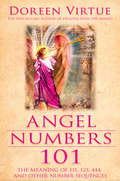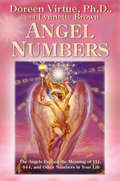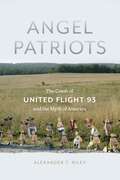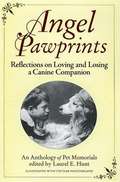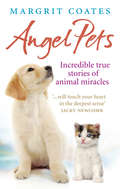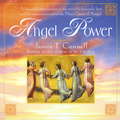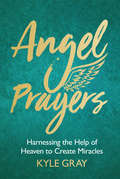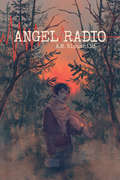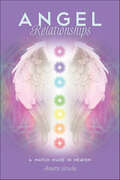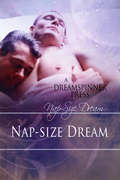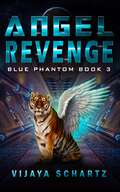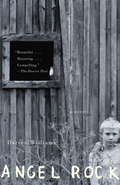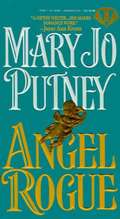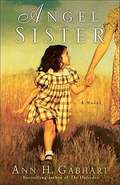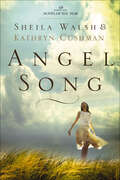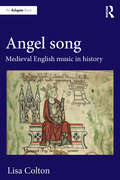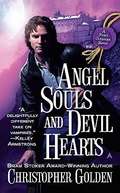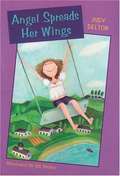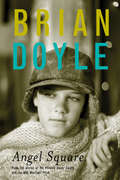- Table View
- List View
Angel Numbers 101: The Meaning Of 111, 123, 444, And Other Number Sequences
by Doreen VirtueOne of the most common ways in which angels speak to us is by showing us repetitive number sequences. Since the publication of her best-selling book Angel Numbers, Doreen Virtue has received even more information from the angels about the meaning of number sequences such as 111, 444, 1234, and so forth. Angel Numbers 101 clearly explains how to receive accurate messages from your angels and heavenly loved ones whenever you see repetitive number sequences on telephone numbers, license plates, receipts, clocks, and such. Every message is completely updated for increased accuracy in understanding your angels’ messages. This handy reference guide is small enough to fit into a purse or desk drawer so you’ll always know what your angels are saying.
Angel Numbers: The Angels Explain the Meaning of 111, 444, and Other Numbers in Your Life
by Doreen Virtue Lynnette BrownDoreen Virtue teaches you the meaning of the numbers and how they apply to your life.
Angel Numbers: The Meaning Of 111, 123, 444, And Other Number Sequences
by Doreen Virtue"Why do I always see the numbers 444 (or 111, 333, etc.) everywhere I go?" is one of the most frequently asked questions that Doreen Virtue receives at her worldwide workshops. In her best-selling book Healing with the Angels, Doreen included a chapter that briefly explained the meanings behind these number sequences, and many people have commented that they carry the book with them everywhere to help them interpret the numbers they see daily. By popular request from Doreen’s audience members, Angel Numbers has been created to serve as a pocket guide containing the angelic meanings of numbers from 0 to 999. Designed to fit into a purse or pocket for easy transport, Angel Numbers provides an interpretation of more complex number sequences than was previously available in Healing with the Angels. This new book focuses on numbers such as 123, 337, 885, and so on. Whether you’re seeing these numbers on license plates, telephone numbers, the clock, or other locations, they’re very real messages from the angels. Angel Numbers will help you instantly understand the meaning of these signs!
Angel Numbers: The Message and Meaning Behind 11:11 and Other Number Sequences
by Kyle GrayDISCOVER THE MEANING OF ANGEL NUMBER SEQUENCES AND NUMBER PATTERNS YOU SEE FROM BEST-SELLING ANGEL EXPERT AND AUTHOR OF RAISE YOUR VIBRATION, KYLE GRAYLEARN WHAT MESSAGES YOUR ANGELS HAVE FOR YOU WHEN YOU SEE NUMBERS FROM 0 THROUGH 999 LIKE 1:11, 2:22, AND 5:55Are you seeing repeating numbers like 11:11 and 4:44 everywhere you turn?In Angel Numbers, world-renowned angel author Kyle Gray explains exactly what your angels and spirit guides are trying to tell you through repeated number sequences you see.In this day and age, our understanding of the cosmos is all calculated using numbers, so it&’s no wonder that angels, the universe&’s greatest divine messengers since the dawn of time, are using numbers to send us signs and messages from heaven.There&’s a good chance you have seen number sequences appearing time and time again in your life—on license plates, purchase receipts, flight numbers and of course your phone—and these numbers aren&’t just numbers, they&’re angel numbers.They are angel messages and calls to action. Now that we are living in what can only be described as a digital age, angels are using the numbers we see on digital clocks, such as 11:11, 1:23, 21:12, 22:22, and 5:55 to help remind you of your higher truth.Some Example Angel Number Meanings:12:12You have the power to bring healing and light to the world. Notice how your intentions and actions are already doing just that.4:44Your guardian angels want you to know that they are with you. Your prayers are being heard loud and clear. Have faith.1:23You are moving up a step. All the challenges you have previously experienced are now being released. The angels of ascension are with you.&“Kyle Gray is one of the world&’s most incredibly gifted angel communicators. I have seen him work and he is authentic, intelligent, and deeply compassionate. I highly recommend him and all his creations!&”– Colette Baron-Reid, international bestselling oracle expertWhenever you need guidance from your angels, simply ask. Angel Numbers is the perfect companion to refer to daily as a reminder that your angels are always listening and sending you loving messages to help with whatever you are going through.
Angel Nurse: Volume 1 (Volume 1 #1)
by Yang HuoZhong liran 27 was a nurse at the hospital because the head nurse had something to do zhong had the opportunity to sneak into the nurse s office to slack off still remember two years ago she just moved to the hospital to work he received her first patient her boyfriend zheng hang then zheng hang has just graduated from university then start your own business one year zheng hang starting to run the business the last to have their own company finally to bankruptcy the last jump off a building suicide from his own office is only two years of time everything changed all the happiness in the moment zheng hang suicide naught
Angel Patriots: The Crash of United Flight 93 and the Myth of America
by Alexander T. RileyWhen United Flight 93, the fourth plane hijacked in the September 11, 2001 terrorist attacks, crashed into a field near Shanksville, Pennsylvania, the gash it left in the ground became a national site of mourning. The flight’s 40 passengers became a media obsession, and countless books, movies, and articles told the tale of their heroic fight to band together and sacrifice their lives to stop Flight 93 from becoming a weapon of terror. In Angel Patriots, Alexander Riley argues that by memorializing these individuals as patriots, we have woven them into much larger story of our nation—an existing web of narratives, values, dramatic frameworks, and cultural characters about what it means to be truly American. Riley examines the symbolic impact and role of the Flight 93 disaster in the nation’s collective consciousness, delving into the spontaneous memorial efforts that blossomed in Shanksville immediately after the news of the crash spread; the ad-hoc sites honoring the victims that in time emerged, such as a Parks Department-maintained memorial close to the crash site and a Flight 93 Chapel created by a local Catholic priest; and finally, the creation of an official, permanent crash monument in Shanksville like those built for past American wars. Riley also analyzes the cultural narratives that evolved in films and in books around the events on the day of the crash and the lives and deaths of its “angel patriot” passengers, uncovering how these representations of the event reflect the myth of the authentic American nation—one that Americans believed was gravely threatened in the September 11 attacks. A profound and thought-provoking study, Angel Patriots unveils how, in the wake of 9/11, America mourned much more than the loss of life.
Angel Pawprints: An Anthology of Pet Memorials
by Laurel E. HuntThis eloquent salute to dogs features the words of famous writers and includes memorable selections by such literary luminaries as Rudyard Kipling, Eugene O'Neill, and William Wordsworth. It also spotlights the heartfelt sentiments of authors unknown-- until now. Written from the early 1800s through the present day, these verses and stories from a timeless tribute to the special place of dogs in our lives and validate the pain and loss experienced when they are gone.
Angel Pets: Incredible True Stories of Animal Miracles
by Margrit CoatesMargrit Coates is an internationally acclaimed animal healer and communicator. In Angel Pets, she reveals how animals talk to us all the time and shares their incredible true stories.Meet Rusty, the lost dog whom Margrit guided home using the psychic connection between them; Mitzi, the brave little cat who made the greatest sacrifice; Twinkle, the determined rabbit who saved a girl's life; Gypsy, the sheepdog with special healing powers; Freddy's friend, the demon cat who was really an angel in disguise, and many, many more wonderful animals.Through these amazing stories, Margrit answers the question that every pet owner will have asked themselves: what is my pet really thinking? Offering helpful tips, she unlocks the secret of tuning into and connecting with pets at the very deepest level.A heartwarming read, this book will change the way you relate to animals forever.
Angel Power
by Janice T. Connell"There are many angels, maybe as many as the stars in the sky . . . ."And every single one of these precious beings offers the world unique blessings. ANGEL POWER describes the special tasks and responsibilities of each of the Nine Choirs of Angels. The Seraphim, Cherubim, and Thrones are angels of goodness, love, and wisdom. The Angels of Dominion are angels of leadership. From the Virtue Angels flow miracles of healing, comfort, and peace. The Power Angels are special warriors against evil and defenders of goodness. The Principalities, Archangels, and Angels administer our planet. By illuminating each Choir's special powers, the author enables us more easily to draw upon its particular, radiant light.Weaving her own personal angel experiences together with angel prayers and with true angel stories she has been told, the author teaches us to open ourselves to angelic guidance, support, and protection. Her book spreads before us a dazzling and profoundly reassuring prospect of angel power at work -- a vision so beautiful and potent that those who experience it feel they know heaven on earth.
Angel Prayers: Harnessing the Help of Heaven to Create Miracles
by Kyle GrayLEARN FROM KYLE GRAY - WORLD-RENOWNED ANGEL EXPERT AND BESTSELLING AUTHOR OF RAISE YOUR VIBRATION, POWERFUL PRAYERS FOR ATTRACTING MIRACLES, HAPPINESS, AND PEACEDISCOVER HOW TO CALL ON ANGELS AND ARCHANGELS WHO WILL SUPPORT YOU AND KNOW EXACTLY WHAT YOU NEED"Kyle Gray changes lives!" – The Sun NewspaperIf you ever feel that your prayers are going unanswered, Kyle Gray is here to change this for good. In this expanded edition of Angel Prayers, Kyle reveals how to use affirmative prayer to bring about positive change in your life.ANGEL PRAYERS SECTIONS INCLUDE:· PART I: The Miracle of Prayer - The Power of Prayer and Angel Prayer Techniques· PART II: Directory of Angels and Angelic Beings· PART III: Directory of PrayersReceive Loving Guidance to Build Your Faith and Intuition Like:· The power of prayer, demonstrated by true stories from Kyle's clients and his own personal experiences· The spiritual laws at play in the world and how your words and intentions affect your life· The Angelic Hierarchy, including the 15 major Archangels and other angelic beings who support you on your journey· Invocations and prayers to call specific Angels and Archangels, including lesser known Angels such as Faith, Hope and CharityAs well as introducing you to angelic beings you might not have heard of before, Kyle also shares powerful prayers to support you through all life events."Your angel loves you beyond your human comprehension. You are their purpose and they are dedicated to your wellbeing on all levels.&“They see you as a perfect, innocent child of the universe and they will do everything within their power to guide you on your way.&“Your guardian angel is with you right this second, waiting for your invitation to help you in all areas of your life.&“As you apply the angel prayers technique to your daily practice and acknowledge the angelic presence in your life, I know miracles will begin to take place.&“My prayer is that you will begin to feel the love your angel has for you and experience the miraculous shifts you deserve to experience. Allow angels to support you on your amazing journey.&”With love,Kyle GrayGet ready to open up to the beautiful world of angel prayers - and to see amazing results!
Angel Radio
by A. M. BlaushildOn the cusp of summer, angels--terrifying creatures of eyes and wings--have laid waste to human civilization, leaving a single survivor. Months later, Erika Cantor is alone in her hometown with no way to make sense of what's happened. Then a strange radio broadcast lures her into the grim outside world, a ruined place reclaimed by nature and inhabited by demons. She soon encounters Midori, a secretive girl with a fondness for the angels. Then there's Gav, a strange boy determined to relentlessly follow Erika. He knows more than he should, but he refuses to answer any of Erika's questions. The enigmatic Fex is even more of a mystery, and he shares his goals with no one. While combing Vermont in search of any remains of world, Erika discovers that the horrific angels have plans for the rest of humanity--and she might play a part in whatever they're plotting.
Angel Relationships: A Match Made in Heaven
by Annette BruchuA guide to learning about and connecting to angels to receive divine guidanceIncludes exercises, meditations, and visualizations to bond with the angelic realmAssists anyone in the search to communicate with and understand angels
Angel Requiem (Wings of Faith)
by Jaime SammsA Wings of Faith short storyIn a world without hope that kills what it can't understand, a solitary priest who has lost all he ever loved may be the last man to still believe in Angels. In the end, his belief may be all that can safeguard the fate of two Angel lovers--and restore his own faith in the power of love.
Angel Revenge: Blue Phantom Book 3 (Blue Phantom)
by Vijaya SchartzAn unruly Valkyrie on a flying tiger, a stern angel in love with the rules, and evil pounding at the gate... What could go wrong? Evil from another universe has infiltrated a secret society of former dictators hungry for power. Having massacred all the angels in his former world, the evil one wants to do the same here. The angels of this universe face their greatest challenge yet... destroy the evil one and avenge their fallen brethren... or the bringer of darkness will enslave us all.
Angel Rock
by Darren WilliamsNovel set in Australia in 1969. Two half-brothers get lost in the countryside surrounding the small town of Angel Rock. Only the eldest finds his way home. Soon after, the body of a 16-year-old girl is found in Sydney. The policeman assigned to her case follows the trail back to Angel Rock where he finds himself searching for both the reason for her tragic death and the answer to his own troubled life. Author is winner of the 'Australian'/Vogel Literary Award. His previous title is 'Swimming in Silk'.
Angel Rogue (Fallen Angels #4)
by Mary Jo PutneyA master spy with the face of a fallen angel and a darkly heroic past, Lord Robert Andreville, returns to his ancestral home in Yorkshire after a dozen harrowing years spying against Napoleon. But nothing soothes his ravaged spirit until a determined young beauty sweeps into his life. Half Mohawk and all-American, Maxima Collins is a wary stranger in a strange land, but she will let nothing halt her journey to London to learn the truth about her father's sudden death-not even a self-appointed guardian who is all lazy charm and dangerous skill. Together they travel across England, evading pursuers and circling each other in a dance of desire, where truth is elusive and only passion is sure. Then dark secrets shatter their idyll- and only love has the power to heal the past.... Chronologically, this is the fourth book of the Fallen Angels series.
Angel Secrets: Transform your life with guidance from your angels (Angel)
by Jacky NewcombIn this enchanting book, the 'Angel Lady' - bestselling author Jacky Newcomb - shares secrets from the angelic realm, and takes you on a journey guided by the angels who embody the key principles of love, family, money, career and other important aspects of everyday life. You will discover angelic wisdom to enrich every aspect of your life, as well as fully-illustrated practical exercises and rituals that you can perform to create a closer connection with the angelic realm. Throughout the book Jacky shares true life stories of angelic intervention and visitation, with stunning contemporary angel images helping you visualize your own encounter with angels. Fresh, magical and beautiful, Jacky Newcomb's Angel Secrets is the perfect guide to the angelic world.
Angel Sister (Rosie Corner #1)
by Ann GabhartWhat a jewel of a story. Reminded me of To Kill a Mockingbird. Like a Kentucky summer, Angel Sister starts slow and easy but by the end, roars along, leaving the reader breathless and wanting more. It is 1936 and Kate Merritt is trying hard to keep her family together. Her father has slipped into alcoholism, her mother tries to come to grips with their dire financial situation, and her sisters seem to remain blissfully oblivious to all of it. Kate could never have imagined that a dirty, abandoned little girl named Lorena Birdsong would be just what her family needs. In this richly textured novel, award-winning author Ann H. Gabhart reveals the power of true love, the freedom of forgiveness, and the strength to persevere through troubled times, all against the backdrop of a sultry Kentucky summer.
Angel Slayer
by Michele HaufDark and sinfully delicious, Michele Hauf’s new series explores the passionate world of angels and demons.... All her life Eden Campbell had dreamed of angels….but none that she painted was like the fallen angel who attacked her. A muse, Eden was now to bear her attacker’s offspring—one who promised the apocalypse and foretold her death. Where else could she turn but into the arms of a mesmerizingly handsome angel slayer? But Ashur’s protection came with a price. The dark, dangerous and oh-so-sexy slayer tormented her, made her remember how long it’d been since she’d had a man. But Ashur was no man, and no angel. He was a demon. Called from Beneath to slay her attacker, he could commit every sin but couldn’t fall in love. And that was the one thing Eden wanted from him. How could she choose between a death sentence or a life without Ashur? Originally published in 2010
Angel Song (An\angel Song Novel Ser.)
by Sheila Walsh Kathryn CushmanAngels eagerly watch over Ann Fletcher's every move. She just doesn't know it yet. Ann Fletcher has returned to Charleston to see her younger sister Sarah receive her master's degree. But she soon finds herself riding in the back of an ambulance, watching helplessly as Sarah fights for her life. As they race to the hospital, Sarah talks to someone who is not there...and hums a melody Ann has never heard before.That unfamiliar, unearthly beautiful melody keeps finding Ann--first in the hospital chapel, then in her dreams, and finally in Sarah's empty house.Two neighbors have a profound effect on Ann. Ethan McKinney lends her a shoulder to lean on. And as a carpenter, he volunteers to help Ann get the Fletcher family home into shape for selling. His strong presence is a pleasing distraction. Ann's twelve-year-old neighbor, Keith, has Down Syndrome and the guile to believe he can actually see and hear angels. In fact, he insists they are looking out for her in ways she's never imagined.God begins to reveal himself to Ann--both in her newfound friends and through supernatural events. As she discovers the very real presence of angels around her, will she finally open her heart to receive God's healing love?
Angel Song: Medieval English Music In History
by Lisa ColtonAlthough medieval English music has been relatively neglected in comparison with repertoire from France and Italy, there are few classical musicians today who have not listened to the thirteenth-century song ‘Sumer is icumen in’, or read of the achievements and fame of fifteenth-century composer John Dunstaple. Similarly, the identification of a distinctively English musical style (sometimes understood as the contenance angloise) has been made on numerous occasions by writers exploring the extent to which English ideas influenced polyphonic composition abroad. Angel song: Medieval English music in history examines the ways in which the standard narratives of English musical history have been crafted, from the Middle Ages to the present. Colton challenges the way in which the concept of a canon of English music has been built around a handful of pieces, composers and practices, each of which offers opportunities for a reappraisal of English musical and devotional cultures between 1250 and 1460.
Angel Souls and Devil Hearts
by Christopher GoldenThe second Peter Octavian novel in the classic urban fantasy series- reissued in a brand-new package-by the award-winning author.
Angel Souls and Devil Hearts
by Christopher GoldenIn the second book of The Shadow Saga the Shadows have been exposed as living amongst us and the ancient vampiric race now finds itself threatened by the most powerful demon of all: human prejudice. In a world where the good are no longer distinguishable from the bad and where Shadows are indeed the saints, a holy war is about to begin, pitting humans and vampires together against the dark forces of Hell. And as they fight for their survival in the face of a betrayal by one of their own, the Shadows begin to discover at last the astonishing, long-hidden truth of what they are. What they will learn about their mysterious origins is more extraordinary -- and more explosive -- than they could possibly have imagined.
Angel Spreads Her Wings (Angel O'Leary #6)
by Judy Delton Jill WeberWith the excitement of her mother getting married and having a baby, Angel is ready for a nice long summer at home in Elm City, Wisconsin. But another change is brewing for poor Angel. Her stepfather is taking the family to Greece to meet their new grandparents. Angel will have to get on a plane and fly over the ocean to a foreign land - will she have to use one of those airsick bags on the plane? Will there be anything to eat in Greece besides those little fish with their heads on? How will she understand her grandparents? And, most important, will Angel ever make it back home or will her stepfather want the family to stay in Greece forever? Back by popular demand, here is another fast-paced, hilarious adventure for that much-loved character, Angel. Change isn't always easy, but even worrywart Angel just may spread her wings a little as she learns that home is where the heart is. Bookshare holds the key to all of the books about angel, the little girl who worries too much. Read about her adventures in: Back Yard Angel, Angel in Charge, Angel's Mother's Boyfriend, Angel's Mother's Wedding and Angel's Mother's Baby.
Angel Square
by Brian DoyleA Phoenix Honor Award Book Young Tommy is seeing Angel Square through new eyes since his best friend's father was beaten up just because he's Jewish. Brian Doyle brings his award-winning blend of humor and wisdom to bear in this mystery that confronts the issue of racial hatred.
